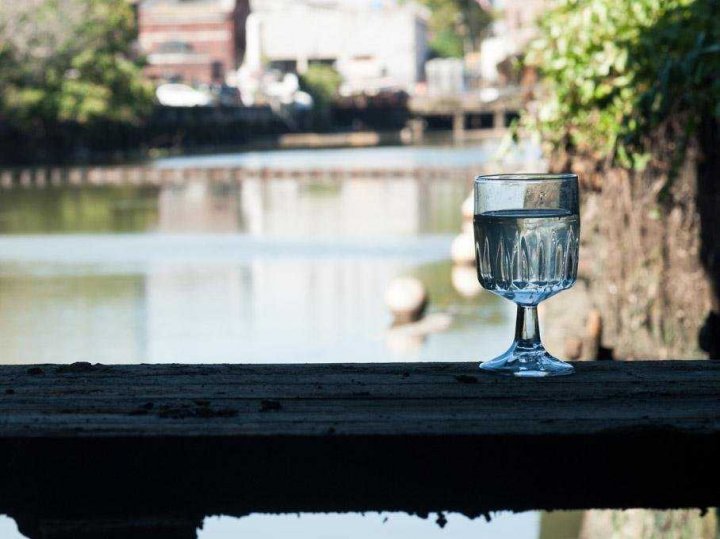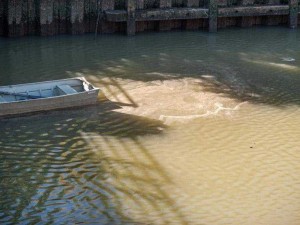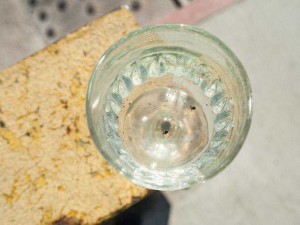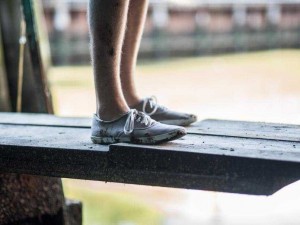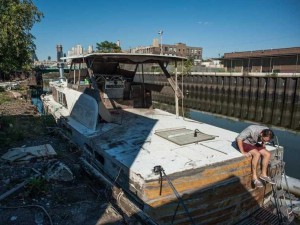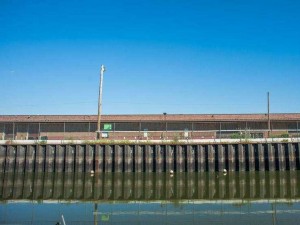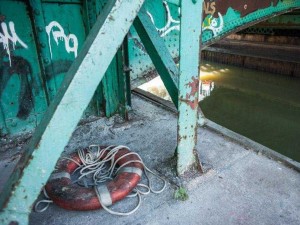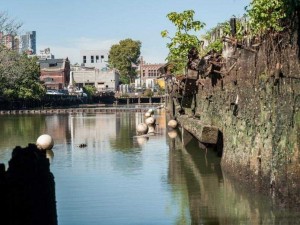“So, right off the bat, you’d have a massive problem with dysentery,” Ludgen Balan, founder of the Urban Divers Estuary Conservancy, told me.
Dysentery, caused by an infection from hostile bacteria or amoebas, results in severe diarrhea, likely with some blood and mucus added as a bonus.
That was the very first thing Balan told me, and the more I looked into the Gowanus Canal, an absurdly, laughably polluted waterway right smack in the middle of gentrified Brooklyn, the more I realized that dysentery is one of the least repulsive things about the Gowanus.
The Gowanus Canal is a 1.8-mile-long waterway connecting Upper New York Bay (the bay in between Brooklyn, Manhattan, New Jersey, and Staten Island) with the formerly industrial interior of Brooklyn. Originally it was fed by the marshland and freshwater springs in Brooklyn and drained into the Atlantic Ocean in Upper New York Bay; the brackish water lent by the mixture of the cool fresh springs and the salty Atlantic made it a perfect home for oysters, which were massive and delicious and pretty much sustained the early residents of New York City.
As the largest creek in the marshy Gowanus area, a waterway called Mill Creek was dredged and enlarged in the 1870s, creating the Gowanus Canal. It was no longer fed by the freshwater springs, those having been largely paved over; instead, it was blocked off at the end opposite the ocean, at modern-day Butler Street. Water from the Upper New York Bay flowed in, but then just…stayed there. There was no need for flowing water, the planners thought, because the canal would only be used to access inner Brooklyn from the ocean.
The canal area soon blossomed with dozens of factories, all serving the nearby neighborhoods of Carroll Gardens, Cobble Hill, Red Hook, and Park Slope. Materials went in, products came out. Thanks to easy access to Manhattan, to the ocean, and now to industry, those neighborhoods exploded in size. By World War I, the Gowanus was the nation’s busiest canal. And nobody had bothered to regulate the sewage situation, so it also became, arguably, the nation’s most polluted.
Factories dumped waste and raw sewage directly into the canal. Con Edison, Honeywell, Kraft, ExxonMobil, Unilever, Viacom, Coca-Cola, Sears — all those good American companies were served notices that they, their predecessors, or their affiliated businesses, are
Potentially Responsible Parties in the contamination of the Gowanus Canal. But the all-time worst offender has to be National Grid, a London-based utility that purchased KeySpan, a natural gas distributor, in 2006. KeySpan is the result of a merger between the Brooklyn Union Gas Company and the Long Island Lighting Company. Back in the 19th century, there were no pipelines, so coal and gas were simply trucked up and down the canal before being cooked, slowly and wastefully, in gashouses. Brooklyn Union was the biggest coal supplier in the city.
On September 30th, the EPA announced that the cleanup plan has been finalized.All those new buildings, residential and commercial, drained their sewage downhill, where it ended up in the canal. Storm water also ran downhill, collecting all sorts of nasty stuff from 19th and 20th century Brooklyn and adding it into the canal. The original planners of the canal somehow thought that the natural tides from Upper New York Bay would flush out the Gowanus Canal.
They did not, at all, so the water in the Gowanus did not move. Without movement, there was no oxygen, so life began to die out. Locals nicknamed it “Lavender Lake,” a name taken, cheekily, by a large outdoor bar that opened last year in the modern Gowanus neighborhood. And there the Gowanus sat, for decades. It changed color, from healthily clear to brown to the modern gray-green. It began to smell. Bubbles of foul air breach the oily surface of the water, created by the decomposition of sewage far below. The canal gleams with swirls of oil. Sun can only breach the opaque water for a few feet, not anywhere near deep enough to allow for the growth of bottom-dwelling plants. During the summer, you can smell it from blocks away.
A few crabs and fish survive, and algae blooms sporadically, changing the color of the water from grayish to greenish. In 2007, a 12-foot-long baby minke whale swam into the Gowanus. Healthy at first, it was soon nicknamed “Sludgy” due to a coat of slimy muck and sediment that covered its body. Its health deteriorated rapidly and it died after a few days. In January of this year, a dolphin, likely already sick, swam into the Gowanus and perished.
In 2009, the Environmental Protection Agency proposed that the Gowanus Canal be listed as a Superfund site, and that stewardship of its cleaning be passed to the federal government. Over the strident objections of Mayor Mike Bloomberg, who believed (probably correctly) that federal control would curtail development in the area, the proposal was accepted, and the Gowanus Canal is currently in the early stages of a major, federally-funded cleanup effort.
On September 30th, the EPA announced that the cleanup plan has been finalized. It’ll cost more than $500 million, require dredging nearly 600,000 cubic yards of contaminated soil, and will probably take decades. If it’s ever done. (Just ask those who have been waiting for a 2nd Avenue subway line about New York’s public works projects’ deadlines.)
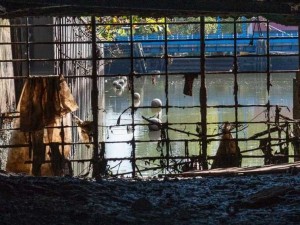 The Gowanus isn’t isolated; it isn’t tucked away in a remote industrial area or behind fences or at the far reaches of the borough. It’s smack in the middle of some of the most expensive, exclusive areas in the entire country. Carroll Gardens, which counts the Gowanus as its eastern border, has an average home price of
The Gowanus isn’t isolated; it isn’t tucked away in a remote industrial area or behind fences or at the far reaches of the borough. It’s smack in the middle of some of the most expensive, exclusive areas in the entire country. Carroll Gardens, which counts the Gowanus as its eastern border, has an average home price of
$1.24 million. I have friends who canoe on the Gowanus. The Gowanus’s mere existence, in the middle of one of the richest parts of the fastest-growing borough of America’s biggest city, is one of those casual New York City things that’s completely unbelievable if you’ve got any distance from it at all. We accept that urban waterways are often dirty; our cities are, too. But the Gowanus is literally a toxic, radioactive waste dump that the federal government says requires half a billion dollars to become tolerable.
* * *
My initial question, “what would happen if you drank a glass of water from the Gowanus,” is flawed; even if the Gowanus is eventually repaired enough to pass EPA standards, the EPA has totally different standards for waterway water and for drinking water. You’re not supposed to drink out of any canal, really. But it was my way to figure out what’s going on in the canal. And it turns out that nobody really knows.
Partly that’s because it’s a lot more difficult to find out if there’s a particular contaminant than it is to find out the identities of all the contaminants. The more inexpensive tests rely on simple nitrate test strips, which turn a different color when the nitrate reacts with coliforms like E. coli. So it’s easy to test for that (and boy, is the Gowanus ever full of E. coli) but to test for every possible contaminant would require hundreds, possibly thousands, of different tests. Frankly, I didn’t have the budget for that; even after cajoling and playing the broke journalist card, no testing company would perform anything near a comprehensive test for less than about four thousand dollars.
But even that wouldn’t really cover the problem, because the Gowanus is one of the most creatively and massively pathogenetic waterways on the planet. We know some things; we know that the quantity of fecal matter, usually measured in parts per million, can be measured in parts per hundred in the Gowanus. But the Gowanus isn’t any one thing; water taken from different parts of the canal, from different depths, will have totally different levels of contaminants, microbes, radioactive materials, or carcinogenic materials. I took a sample, pictured throughout this article, by hanging off of some scaffolding underneath the Union Street bridge — but that’s surface water, in the shade, near shore (“shore” in this case being foul, reddish mud), in one part of the canal.
That water is polluted and dangerous as hell, but it’s polluted and dangerous in an entirely different way than most other water in the Gowanus. This is what happens when you have a huge, 1.8-mile waterway that’s completely stagnant: you get micro-environments, because there’s hardly any interaction between the water I grabbed and, say, water a few inches above the muck in the center of the canal.
The other, bigger problem is that there’s essentially no funding for testing. We don’t really know what’s in there, we don’t know what’s in the soil and air around it, and we don’t know how it affects the tens of thousands of people who live within a few blocks of it.
We don’t really know what’s in there.Nasreen Haque, a microbiologist who has studied — or attempted to study — the microbial makeup of the Gowanus, was teaching at the City University of New York a few years ago. As an exercise, she decided to have her students test for microbes in water she assumed would have some — the Gowanus. “We found that everything we threw at it, every kind of imaginable pathogen, was growing there,” she told me.
But here’s where it gets nuts: in the stagnant water of the canal, fed by chemicals from raw sewage, tar, and rotting garbage in the sludge at the bottom of the canal, they’re breeding and evolving into new forms we’ve never seen before, in concentrations seen in few other places on Earth. It was only in 2008 that Haque conducted a study revealing the white clouds of “biofilm” that float just above the sludge at the bottom of the canal. The clouds aren’t microscopic; they’re giant clumps of white gunk that nobody had ever seen before, because hardly anyone has ever been submerged in the canal, because Jesus Christ, why would you go in the canal.
Microbes shouldn’t be able to survive in the Gowanus; it’s estimated that the oxygen levels are at 1.5 parts per million due to the lack of circulation, less than the 4 parts per million needed to sustain a healthy population of marine life. And yet they’re thriving, mutating into new forms. “Nobody is researching the microbial makeup of the Gowanus,” said Haque. But it might even be to their benefit; the purpose of her study was to see if these mutated microbes could hold the key to new antibiotics.
As you can see in this sampling (PDF), taken by the EPA shortly after Hurricane Sandy, there’s basically no test at all for microbial content. The test for Enterococcus you see there is basically a canary in a mineshaft; that particular bacterium is believed to have a strong correlation with the concentration of other pathogens in a body of water. If a body of water tests highly for Enterococcus — and boy, does the Gowanus test highly — it’s a pretty good sign that there’s a whole bunch of other nasty stuff going on in there too.
Haque only discovered the white clouds of biofilm because she is one of very few to have dived beneath its surface. Hardly anyone has every actually gone into the water; the Urban Divers Estuary Conservancy is about the only organization that does it (Haque made her dive with the help of the Urban Divers). The testing itself is very difficult for an environment as dense and varied and unknown as the Gowanus.
“Normally, you’d get a sample, bring it to the lab, and try to grow it, but you’ll only see the microbes that best respond to the nutrient you provided,” says Haque. “If you put in ten different nutrient types, you’d grow ten different types of bacteria.”
It proved enormously difficult to figure out what’s in the Gowanus and its effect on the community. The EPA doesn’t know. When I asked about microbes and carcinogens, Elias Rodriguez, press officer at the EPA, replied “The Gowanus Canal Superfund Site remedial project manager said that we do not have this info.”
I wasn’t asking for crazy science stuff; I was asking if there were common, well-understood microbes like E. coli or parasites like Giardia. The EPA has no idea. This did not help my quest to find out what would happen if I drank some.
In fact, though the EPA says “Exposures to hazardous or toxic air pollutants are within EPA’s risk ranges, which means that EPA does not consider them to present an unacceptable risk,” the EPA also has no idea about the long-term effects on people who live near the canal. Haque attempted to get funding for a survey to see whether people near the canal have higher rates of cancer or other illnesses.
“We tried to find out. What kind of infections are more prevalent?,” she said. “Is there anything more common in that area compared with another area? That could help us understand the health status of that particular community better.” Her request for funding was denied. When I asked whether anyone else was doing this kind of research, she answered flatly. “No.”
“We are limited by funds. The funds go towards things like cancer and heart disease, because these can be treated with drugs, which are very expensive, so you can sell more,” she explained. “Who wants to study these pathogens?”
Pathogens are the key to the sexy answer to this question, and nobody’s studying them. I wanted to find out if I’d get explosive diarrhea, if I’d puke so much I’d pull a muscle, if I’d develop malarial fever dreams or lodge a flesh-eating worm in my lower intestine or lose all my hair thanks to a mutant radionuclide deposited a hundred years ago by an enormous utility company like National Grid to whom I’m still paying bills every other month for my gas stove.
Given the levels of fecal matter and coliforms in the Gowanus, everyone I spoke to pretty much agreed I’d end up with, on the bacterial side, some pretty nasty gastrointestinal punishment, ranging from some light puking to full-on
E. coli or dysentery. Parasites? Probably not. The lack of oxygen would make it difficult for any sizeable worm or other parasite to survive in the Gowanus proper. So, um, that’s one silver lining, I suppose. But certainly I could expect to spend some time really getting to know my toilet.
There’s very little data on the microbial makeup of the Gowanus, but the EPA, the Department of Environmental Protection, and other governmental and non-governmental groups have measured other dangers lurking in (and beneath) the water: heavy metals, carcinogens, congeners, and more.
The EPA recommends people avoid the canal water, the land around it, the air above and adjacent to it, and anything that swims or crawls in it. There are highly carcinogenic materials in the land and water, including polychlorinated biphenyls (PCBs) and polycyclic aromatic hydrocarbons (PAHs), which are found (and banned) in some plastics, or in the charred parts of grilled food.
There is literally liquid coal tar in the Gowanus, bubbling up from the muck towards the surface. There are also high concentrations of heavy metals, like arsenic, lead, iron, manganese, cadmium, and zinc. Those aren’t toxic immediately, and indeed humans need a small amount of some of those metals, but they’re all rated at an unsafe level in the Gowanus. If they get into your system and build up, they become highly carcinogenic. Let’s start off with a real easy one: arsenic.
“Arsenic at ten locations with maximum concentrations of 8.2 µg/L and 7.8 µg/L for dissolved and total concentrations, respectively, compared to the human health screening value of 0.14 µg/L,” reads one EPA Gowanus report.
Arsenic is a poison, plain and simple, and the dissolved concentration of arsenic in the Gowanus reaches nearly 60 times the human health screening value, which is the point at which exposure becomes unsafe. Arsenic needs to build up in the system, so one glass won’t have too much of an effect — but a glass of that hyper-arsenic-filled water will lift your arsenic levels dramatically.
Keep it up and you’ll end up with drowsiness, then confusion, then severe diarrhea, then convulsions and cramping, then blood in the urine, and soon enough, a coma and death. Cool.
Copper poisoning is even uglier, if you can believe it. It works a bit like arsenic poisoning, in that you need exposure for awhile, but copperiedus, as copper poisoning is known, is horrific. We’re talking vomiting of blood, black and tarry feces, jaundice, and burns. The Gowanus has copper concentrations of about 16 µg/L, around 15 times more than what the EPA considers safe — though that EPA number assumes you’ll be drinking only that coppery water for your whole life.
Probably copper will not be a problem here. Copper and arsenic are the big bad heavy metals in the Gowanus, and both require buildup, so in terms of our central question? The basic answer is, probably a headache from the blast of arsenic, but not much more, assuming you don’t get a taste for the Gowanus water.
Let’s move on to cancer.
Both the EPA and National Grid conducted PCB concentration studies in the past two years. Surface sediment tests in normal New York City reference areas (there are five, all around the five boroughs) range from 0 to just under 2 mg/kg. In the Gowanus, they’re twice that ±on the surface. Go a little bit deeper and that skyrockets. The 2012 National Grid survey found levels of 66 mg/kg of PCB congeners in the “soft sediment,” which is not mud, exactly, since the muck at the bottom of the Gowanus Canal can sometimes rise to 20 feet of repulsive, cancerous goo.
So what would happen if you downed a bunch of that PCB-filled water? Let’s just take it for granted that it’ll vastly increase your risk for cancer. There are about a hundred studies proving that PCBs are linked to cancer. So, what else? It’ll screw your immune system; studies using rhesus monkeys indicate that imbibing PCBs increases your risk of Epstein-Barr syndrome, makes you more susceptible to pneumonia and lots of viruses, and shrinks your thymus gland (which is a key weapon in your fight against diseases). On the reproductive side, you’re looking at decreased conception rates, birth weights, and sperm count.
That stuff lasts forever, by the way; you might not notice until you try to have a kid. It’s wildly bad for children or women who are nursing; young monkeys and human children show significant learning deficits, loss of vision, and loss of short-term memory. Then there’s PAHs, polycyclic aromatic hydrocarbons. They’re also renowned carcinogens, associated with wildly increased risk of cancer as well as many of the same developmental problems as PCBs. And if you’re unlucky enough to get a little dose of coal tar in your glass, you could suffer “pitch poisoning,” in which you suffer vascular collapse, capillary damage, and possibly renal damage.
I can’t generalize, because some parts of the Gowanus have no coal tar and some have lots, but if you snag a glob of tar, well, that could be it for you. A lethal dose is somewhere between 100 and 200 mg/kg. Assuming you don’t, you’ve still got heavy metals and wild carcinogens. That’s another answer to the question “what would happen if you drank water from the Gowanus.”
Maybe nothing but some diarrhea, right now. Maybe E. coli or some other bacterial illness. But it’s also fairly likely that you could develop cancer thanks to build-up in your body. It’s likely that’s already happening; anecdotally it’s been suggested that residents of Gowanus are more likely to succumb early to cancer, but without funds to study it, we have no idea.
Haque says children and those with compromised immune systems are most at risk — but many of these microbes can simply get into your body and wait for your immune system to let its guard down.
You don’t have to have HIV, either; when you have a simple cold or the flu, your immune system is spending its time battling that illness rather than guarding the gates of your body. Microbes from the Gowanus, mutated and unpredictable, could well notice and decide that’s the time to attack. Suddenly you don’t just have a cold. You have life-threatening pneumonia, or internal infections, or organ failure. Or your kids do.
* * *
Mayor Bloomberg opposed the listing of the Gowanus as a Superfund site, specifically stating that it would “inevitably be super slow” to have the federal government handle the cleanup. But his office had previously voiced concern that a cleanup plan outside of his control would negatively affect development in the booming Gowanus neighborhood. (The only other outspoken critic of the Gowanus’s Superfund designation was Toll Brothers, a real estate development firm.) Ludgen Balan called the mayor’s position on the canal “disgusting,” and says Bloomberg’s plan involved dredging the canal and using the sludge to create an artificial island — which he would then sell to developers.
Cleaning up the Gowanus is a project of difficulty so high it’s hard to even imagine it. The first step, obviously, is to stop companies from dumping sewage and waste materials into it, which was happening as recently as 2009 en masse and is still occurring today thanks to the small businesses (repair shops, that kind of thing) along the canal. Even worse and more insane, whenever the sewage tanks at the blocked end of the canal overflow, which they do often, that raw, untreated sewage heads right into the Gowanus.
The EPA is requiring some giant new retention tanks to try to stop that, because it is ridiculous, and if that wasn’t implemented, the canal would just re-pollute itself after the cleaning effort. So! The cleaning effort! The basic repair plan from the EPA, released on September 30, will divide the canal into three sections. Each section will be have its water siphoned off — “sucked through a straw,” says Balan — drained, and treated.
The sludge and the toxic soil around the canal will be dredged and moved…somewhere. The release says there will be several methods for treatment, depending on the level of contamination; muck heavily tainted with coal tar will have to be “thermally treated” — yeah, burned — while less contaminated sediment will be treated and put to an as-yet-undefined “beneficial reuse.”
At the bottom of where the canal used to be, they’ll try to “cap” it — basically sealing in whatever gunk has leaked down even further. There’ll be a few layers of absorbent materials, sand, gravel, and rock, with clean sand placed on top to try to “restore the canal bottom as a habitat.”
Then they’ll install a pump on the inland side of the canal, and open up the bay side, allowing the water to rush in. The pump will circulate the water, so we don’t end up in the same predicament we’re in now. Balan wants to turn the land along the canal into a slim park, planting native trees, grasses, and plants. That’s not just for appearances; marshland vegetation has a vital role in preventing erosion and fostering a healthy ecosystem.
This will involve a lot of displacement. Some people will be kicked out of their homes. Some homes and old buildings will be destroyed. Some businesses will shut down. The EPA’s initial estimate of just over a half-billion dollars, Balan and Haque both argue, is not nearly enough to assess the health of the canal and assure it’s a safe place to live. It could take decades. Or it could never happen.
* * *
For now, the answer to my question — what would happen if I drank the Gowanus? — seems to be a horrified “nobody knows, but nothing good. And probably diarrhea.”
Related articles

